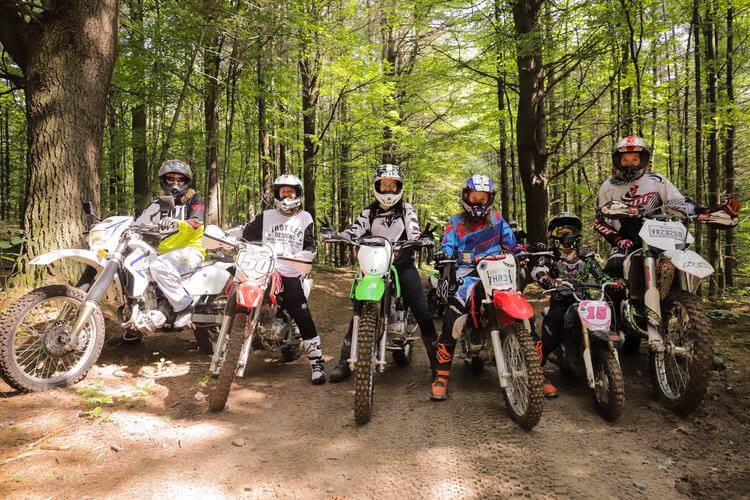One of the fastest growing demographics in the sport (and in the BMA) is ladies who ride. This is not only great for the Club, it is awesome for the sport!

This could almost be an entire section on its own. We will re-use some of the material from the “Options for Shorter Riders” section and others as they apply “in general” to bikes that are better suited for the ladies. Forgive the generalities mentioned here. These may not be true for you! The reality is, there are no “ladies specific” dirt bikes on the market. But there are some better options than others.
Now let’s talk about “your” height and weight in the real-world context. In the real-world, any other category of dirt bike other than mini-bikes and some recreational dirt-bikes are designed for ~5’10” > 6’ tall 170-190lb riders! (Let’s call it like it is: “Men!”) There are exceptions to this of course. But this is an average that manufacturers seem to design and build for. This makes bike size/height the biggest challenge in finding a bike that is the right for most ladies.
I general terms, the handlebar, hand controls and foot pegs are well within reach for most people on most bikes made. The issue is more being able to touch the ground when not moving, or having to “dab” your foot momentarily to maintain balance while on the road or trail.
Manufacturers are s-l-o-w-l-y starting to figure out that 37-38” seat heights make it very difficult for those with shorter inseams to enjoy off-road or dual-sport riding. Although once you manage to swing your leg over that height, the suspension will compress ~2-3” making reaching the ground at least a “possibility” for some.
This leaves those with short inseams 3 general options:
- Shorter Recreational or Dual-Sport Bikes – See the Recreational Bike category for suggestions here. Shorter bikes sometimes come with smaller wheel sizes as well. Models like the CRF150 and KLX140 have the smaller wheel size (~16-17″) while the TTR230 and CRF230F have the full-size (18-21″) wheels. Suzuki and Yamaha make dual-sport models with shorter seat heights via the DR200-S and TW-200 models. Although road-legal, these two models are more dirt than road oriented and a great starter option.
- Shorter Trail / Enduro Bikes – There is a small and (hopefully) growing segment of Models being built that are well suited to those with shorter-inseams. Although these shorter Trail / Enduro bikes compliment a shorter inseam, they maintain most of the capability and performance of the Enduro bike segment. We will have to give some model specific examples as it is a short list:
- KTM Freeride
- Beta Xtrainer
- “Lower” your favourite bike – Many riders aren’t aware that you can actually modify the height of your dirt bike to suit you. There is not one simple adjustment “switch”, but there are many different modifications that can have the same effect. Getting a bike to fit you properly will significantly improve your feeling of comfort on long or more technical rides. Until you are more experienced, take your bike to your favourite local shop and discuss your options to have your bike lowered. These options can range from simply shaving down the foam on your seat to complex modifications of your suspension.
Once you have the suspension/seat-height variable checked off, you’re left with the displacement (CC’s… 125, 250, 300, 450CC, etc) decision. In general terms, the larger displacement bikes are heavier and more powerful. If you are prone to a couple tip-overs-per-ride (we ALL are), picking up a heavier bike is going to drain your energy that much faster.
Based on the ladies we have seen at our training and riding events, a typical displacement bike we see is a ~125 – 250CC. Ironically, most of this is due to the physical size of these smaller displacement bikes!
Last but not least… The “magic” button. Most modern bikes (Recreational, Trail and even Motocross) made today come with a battery and electric-starter. Push the button and go… Kick-starting a bike is great for cardio. But not when you are already drained physically, on a hill or just plain tired. We can’t tell you that you “need” an e-start bike. But it sure makes a typical trail-ride that much nicer.
Talk to your local professional/dealer if you want to learn more. Choosing a bike needs to be based on many variables. Outside of your physical characteristics, budget and preference/feel all come into play.